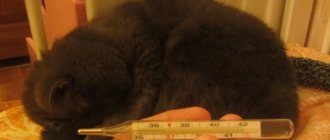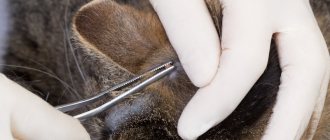11475Administration
This article will talk about what the body temperature of sphinxes should be. And also what should be done if your pet has an elevated temperature or hypothermia.
Normal body temperature for sphinxes
Contrary to many speculations, the temperature regime of the Canadian or Don Sphynx breed is no different from other cats.
Often, people mistakenly believe that the normal body temperature for a Sphynx is 42 degrees. This opinion was born in connection with touching the skin of a cat. Tactilely, the pet's skin seems very hot to the touch, since it is practically not covered with hair.
Based on the above, we understand that the correct temperature for an adult is no more than 38 - 39 degrees.
During the kitten period, the Sphynx's temperature is slightly higher than that of an adult animal. The difference is approximately 0.5 degrees. This phenomenon is due to the fact that active processes of growth and development take place in a young body.
© shutterstock
For owners of this breed, the most pressing issue is always the control of the pet's thermoregulation. Since, despite the general health of the breed, the Sphynx has a weak point in this aspect. This is due to the lack of undercoat, which, with improper care or insufficient attention, leads to either hypothermia of the animal or heat stroke.
Temperature changes are especially dangerous for kittens. Kittens are not able to independently thermoregulate and at a temperature of 18 degrees they can get hypothermia, which can lead to death.
An adult cat looks for a warmer place during cold periods, and tries to find coolness during hot periods. From this it should be understood that an adult Sphynx can regulate its heat exchange.
However, sphinxes should be protected from drafts; they can easily get hypothermia, which can lead to dire consequences. For example, such as: rhinitis, laryngitis, pneumonia, pleurisy and even death.
Normal body temperature in cats
A cat’s normal temperature is 38-39 degrees, and the indicators depend on many factors and can change during the day. For example, a cat that is sleeping or has just woken up will have lower levels because the animal does not expend energy while sleeping.
During active games, the temperature rises. The same thing happens to an animal’s body as to a person during physical activity. There is no need to worry about your pet; as soon as he calms down, the t readings will return to normal.
The kitten's body temperature will always be higher than normal. The little ones learn about the world, experience a lot of emotions, are extremely active, and this is the reason for the mild and harmless fever.
During the period of estrus, pregnancy, childbirth, after sterilization surgery and vaccinations, cats usually experience a sharp jump in body temperature. But you should worry if the thermometer shows more than 40 °C for 3-4 days.
Important! The thermoregulation mechanism in kittens develops over time, so a slight increase in indicators is considered normal. The situation stabilizes by the age of 6-7 months.
| Breed, age of cats | Normal t in degrees |
| Newborns | 35,5-36,5 |
| 1-2 months | 38,5-39,5 |
| 7-8 months | 39-39,5 |
| From 5-6 years | 38-39 |
| Sphynx cats | 39-39,5 |
| Cats of wool breeds | 38,5-39,5 |
Thus, the normal temperature for a cat is 39 degrees. The skin of Sphynx cats seems hotter, but only due to the lack of a fur layer. A healthy hairless cat should not have a body temperature higher than 39.5.
Alarming symptoms: when to measure your pet's temperature
Just like people, animals can suffer from fever and chills. In medicine, an increase in t values is called hyperthermia, a decrease is called hypothermia. Both conditions are equally dangerous and can be signs of illness.
| Signs of hyperthermia | Signs of hypothermia |
| The pet loses its appetite and does not drink water | Severe lethargy, weakness, trembling |
| The cat hides from its owners and spends a lot of time sleeping | The cat is trying to warm up, hiding under blankets, rugs |
| Noticeable fever, trembling | The fur visibly rises (to retain heat) |
| Diarrhea and vomiting (sometimes) | There is pallor of the mucous membranes of the eyes and mouth |
| Signs of dehydration are visible: lethargy, weakness, dull eyes | Blood pressure decreases, the pet moves little |
| Pulse and breathing slow down, time between heartbeats increases |
All signs require immediate temperature measurement. Fever or chills cannot be determined by the condition of the nose.
Important! A dry and warm nose is a normal condition in healthy animals during sleep, rest, and in older cats.
When it rises
Most often, an increase in temperature indicates some kind of disease. So, with paratyphoid fever it rises to 41°C, the calf loses its appetite. With bronchopneumonia it reaches 40-42 °C. Sometimes it becomes high only at the beginning (colibacillosis), and then decreases to 32 -34 °C. Often these diseases are accompanied by other symptoms: diarrhea, lethargy, loss of appetite.
If signs of disease appear, you should call a veterinarian who will examine the calves and prescribe treatment.
A calf with a fever does not want to suckle the udder
How to measure a cat's temperature correctly
A regular thermometer is suitable for measuring the temperature of kittens and cats. But there must be a separate one for pets, and the owners choose which one.
Mercury - gives accurate parameters, but it must be held for at least 5 minutes. Plus - it is inexpensive, minus - it can break, and mercury vapor is harmful to people and animals.
Digital Thermometer. Pros: can be used for rectal and oral measurements, quickly determines indicators. The downside is that the hard plastic tip can cause pain and discomfort to the animal.
A contact infrared thermometer is inserted into the ear canal and removed after a signal. Plus – ease of use, minus – not used for otitis.
Non-contact infrared device. The device is called a pyrometer and is used to measure temperature without touching the body. The device takes into account infrared rays, but often shows an error within 0.1-1 °. This device is not suitable for accurate measurements.
Rectal electronic thermometer. The best option for cats. It is maximally adapted to the characteristics of the animal’s body, equipped with a flexible rubber tip and produces results within 1 minute.
Rules for measuring body temperature in cats:
- it is preferable to use the rectal method, as it is the most accurate and safe for the animal;
- Before measuring the temperature, you need to calm the pet, if possible, wrap it in a large towel;
- lift the tail, insert the device into the anus in a circular motion;
- insert the tip carefully so as not to damage the animal’s internal organs and do not insert the thermometer more than 10 mm into an adult cat or 0.5 cm into a kitten;
- if necessary, lightly lubricate the tip and anus with medical Vaseline;
- calm your pet with strokes and prevent him from struggling during the measurement process;
- wait for the signal and carefully remove the device.
After the procedure, the animal must be calmed down, the readings must be recorded, and if the cat’s body temperature is critical, call the veterinarian immediately.
Important! It is permissible to measure the temperature of 2-3 cats with one device, but only after thoroughly disinfecting the tip and the entire thermometer with an alcohol solution.
How to measure correctly
The question arises: how should you properly measure a cat's temperature? Just as a person cannot simply put a thermometer under his paw, another method will be required. The thermometer will need to be inserted into the animal's rectum. The following describes in detail all the steps of this difficult part.
For this task, it is better to use an electronic rectal thermometer. Its error will not be great (0.1-0.5 C), but you will save time and the animal will not experience so much stress and pain. As a last resort, you can use an electronic or mercury thermometer. In the first case, the measurement will be just as fast, but there are risks of causing pain to the animal. In the second case, a long measurement time will be added to the painful sensations.
- It is advisable that 2 people should participate in this operation. One will measure, and the other will directly hold the cat.
- Lubricate the tip of the thermometer with Vaseline or oil to make it fit easier.
- Hide the cat in a thick cloth, such as a towel. This is necessary to avoid unnecessary movements.
- Calm the animal before inserting the thermometer. It should be inserted with a slight rotating motion and shallowly, about 1 cm into the rectum. Hold the thermometer at a slight angle to press it against the intestinal wall.
- The electronic thermometer will beep when the temperature is measured. If using a mercury thermometer, time for about 4-6 minutes.
Rectal thermometer
Possible causes of hyperthermia
If, after active games, a cat’s temperature is 40°C, this is not a reason to worry; as soon as the pet rests, the temperature will return to normal. But when an animal in a calm state shows obvious signs of illness, measures need to be taken.
The causes of hyperthermia can be:
- Viral diseases. The animal's body reacts to viruses with heat. This is manifested by a high body temperature in the cat, at which microorganisms die.
- Inflammatory processes. Particularly pugnacious cats and female cats are “lucky” for cuts, lacerations, and bites—bacteria enter the wounds and inflammation begins. Also, the process often occurs after operations, when the cat’s care is not of sufficient quality.
- Long exposure to the sun. Overheating in a stuffy room, a closed car, or outside in direct sunlight produces intense heat. Most often, older animals and kittens suffer from elevated temperatures due to overheating.
- Severe stress or prolonged irritating emotions. For example, a fight with a strong opponent or severe fright can cause hyperthermia in a cat.
- Vaccination, sterilization. If the fever does not subside within 24 hours, the animal must be taken to the veterinarian.
Attention! The cat's temperature should not be higher than 39.5 degrees. Hyperthermia is defined when the thermometer shows 40 degrees or higher. Indicators of 41 degrees are considered critical.
What temperature is considered critical?
The critical level is 37C and 40.5C. This temperature is a clear sign of illness and problems in the animal. But what signs accompany all this? The simple method of touching the nose will not help because it is false.
Symptoms of elevated temperature:
- Refusal of food and water.
- The pulse rises to 200 beats per minute. The norm is 150 beats per minute.
- The mucous membranes become inflamed.
- He hides and sleeps longer than usual.
- Vomiting or loose stools are common.
- In the worst cases, the animal begins to become exhausted.
Symptoms of low temperature:
- Lethargy and weakness are noticed, the cat begins to tremble due to fever.
- Sleeps more than usual, begins to hide in warm places and refuses to leave them.
- The wool stands on end to further retain heat.
- Heart rate and breathing slow down.
Kitty
How to reduce a cat's fever at home
If the cat has a high temperature, you should not wet the cat’s fur or wrap the animal in a damp towel, use folk remedies, or independently reduce the fever with medications intended for treating humans.
And now about how to help and what you can give your cat when a fever appears:
- Place your pet in a cool room. The optimal air temperature should be about +20 °C. If an animal is overheated in the sun, it is strictly unacceptable to immediately bring it into a cold room. It is best to place the cat in a chair or on a bedding, gradually lowering the air temperature to +18 degrees. Windows and doors should be closed - a draft will provoke a cold.
- Give plenty of warm fluids in doses of no more than 1 tsp. with a frequency of 1 time every 20-30 minutes. It should be clean, cool (but not cold) water. Water should be given to cats with a syringe without a needle - bring the nose of the syringe to the mouth, lightly press with your fingers on the corners of the jaws so that the pet opens its mouth. Some owners give water with a pear, but in this case there is a risk of giving the cat water with air.
- Take care of a light diet. Remove dry cat food and natural food, but leave light chicken (warm) broth - this food will help the cat regain strength.
Important! Symptoms of dehydration: vomiting, diarrhea, severe fever, tremors, lack of urination.
If dangerous symptoms are observed and the body temperature cannot be reduced, the animal should be shown to a veterinarian. It is strictly unacceptable to treat your pet on your own.
Harm or benefit of heat
High fever in animals is not the norm. But how can you determine that it has increased? Should I lower it right away?
How to determine a promotion
An experienced mother, if her child has a fever, will recognize it immediately: as soon as you touch the baby who has a fever, it becomes clear that he is very hot. In this way, it is impossible to find out whether a cow has it. The animal gives off heat, reducing blood circulation in the skin. Therefore, the skin of animals is cool to the touch. But because heat causes intense metabolism, their muscles may tremble. Therefore, if in doubt, measure the calf's temperature using a thermometer. There are no other ways to determine its increase.
Should you be afraid of the heat?
As with human treatment, fever is more of a plus than a minus. In this way, the calves’ body fights infection. Thanks to its increase, the animal’s defense organisms work faster. In addition, it kills pathogens or prevents them from multiplying. Therefore, it is the most important assistant in the fight against the disease. In the animal's body, the temperature rises due to special substances - pyrogens. They are produced when inflammation or infection occurs.
Elevated temperatures in calves may help them recover faster
In addition to the pros, there are also cons. It puts a lot of stress on the calf’s body and its metabolism. Therefore, the veterinarian may prescribe antipyretics, especially since these medications simultaneously reduce inflammation and relieve pain.
What to do if you have hypothermia
Hypothermia, or low body temperature, also has symptoms and can only be treated by a veterinarian.
The main causes of hypothermia:
- hypothermia due to prolonged exposure to the street, in a humid environment;
- prolonged fasting;
- pathologies of internal organs: heart, blood vessels, liver, kidneys, endocrine system;
- viral diseases with a general decrease in immunity;
- significant blood loss.
Important! If an animal suffers from excessive aggression and fights frequently, internal bleeding may occur from bruises and falls.
What to do at home if your cat has a very low temperature:
- Place your pet in a warm room. Do not sit next to a radiator or other heat source; it is better to prepare a warm bedding (you can make a “nest” of blankets).
- Place a heating pad with hot water nearby.
- Give plenty of warm drinks. Adult cats should be given water from a syringe without a needle, kittens - from a pipette.
If such measures are not enough and the temperature does not increase, then the animal must be urgently taken to the veterinarian. Hypothermia is as dangerous to health as fever, so without timely help the cat may die.
Not every owner has the opportunity to quickly deliver their pet to a veterinarian. In this case, you can contact a doctor from a 24-hour clinic by phone. Experts never refuse advice, especially when it comes to saving the life of a defenseless animal.










